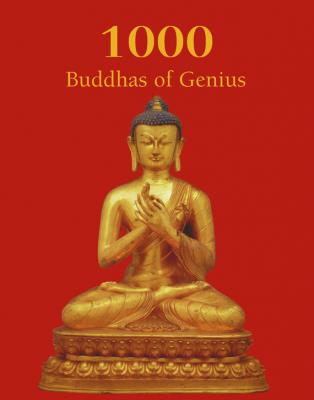1000 Buddhas of Genius. Victoria Charles
Читать онлайн.| Название | 1000 Buddhas of Genius |
|---|---|
| Автор произведения | Victoria Charles |
| Жанр | Энциклопедии |
| Серия | The Book |
| Издательство | Энциклопедии |
| Год выпуска | 0 |
| isbn | 978-1-78310-957-9, 978-1-78310-463-5 |
1000 Buddhas of Genius
© Confidential Concepts, Worldwide, USA
© Parkstone Press International, New York, USA
© Liu Xiao Xian copyright reserved
© Solias Mendis copyright reserved
© Jeremy Richard/ Dreamstime.com
© Donald L. Sanders copyright reserved
© Michael Tong copyright reserved
© Joachim Wendler – Fotolia.com
1. Seated Buddha on Altar, date unknown, location unknown, painted and gilt bronze.
2. Seated Buddha, date unknown, location unknown, paint and gold.
The Life of the Buddha
3. Head of Buddha, date unknown, Shwedagon Pagoda, Yangon, Burma, gold.
The Life of Gautama, Down to the Time of his Appearance as a Teacher:
Around 500 BCE, at a place called Kapilavastu on the banks of the river Rohini in what is now Nepal, there settled a tribe named the Sakyas. The river rose thirty or forty miles to the north of their settlement in the spurs of the mighty Himalayas, whose giant peaks loomed up in the distance against the clear blue of the Indian sky. The Sakyas had penetrated further to the east than most of their fellow tribes, but beyond them in that direction was the powerful confederation of the Licchavis and the rising kingdom of Magadha, while behind them to the west lay those lands which the Brahmans held most sacred. Their nearest neighbours to be feared were the subjects of the king of Sravasti, the rival of the king of Magadha. It was this rivalry more than their own strength that secured for the Sakyas a precarious independence; but their own hand was strong enough to protect them against the incursions of roving bands from the hills, and to sustain them in their quarrels with neighbouring clans of the same standing as themselves. They lived from the produce of their cattle and their rice-fields; their supplies of water being drawn from the Rohini, on the other side of which lived the Koliyans, a kindred tribe.
The Sakyas sometimes quarrelled with the Koliyans for the possession of the water supply, but at this moment the two clans were at peace, and two daughters of the raja, or chief, of the Koliyans were the wives of Suddhodana, the raja of the Sakyas. The story tells us that both were childless, a misfortune great enough in other times and in other countries, but especially then and in that culture where it was firmly believed that the state of a man’s existence after death depended upon ceremonies to be performed by his heir. The rejoicing, therefore, was great when, at the age of 45, the elder sister promised Suddhodana a son. In accordance with custom, she started off with the intention of being confined to her parents’ house, but it was on the way under the shade of some lofty satin trees in a pleasant grove called Lumbini that her son, the future Buddha, was unexpectedly born. The mother and child were carried back to Suddhodana’s house; there, seven days afterwards, the mother died. The boy, however, found a careful nurse in his mother’s sister, his father’s other wife.
Asita, the seer, visits the newborn prince (from the Pali Canon, the standard collection of scriptures for Theravada Buddhism):
[Date: -80 BE]
Asita the seer, in his mid-day meditation,
saw the devas of the Group of Thirty
– exultant, ecstatic –
dressed in pure white, honouring Indra,
holding up banners, cheering wildly,
and on seeing the devas so joyful and happy,
having paid his respects, he said:
“Why is the deva community
so wildly elated?
Why are they holding up banners
and waving them around?
Even after the war with the Asuras
– when victory was the devas’,
the Asuras defeated –
even then there was no excitement like this.
Seeing what marvel
are the devas so joyful?
They shout,
they sing,
play music,
clap their hands,
dance.
So I ask you, who live on Mount Meru’s summit.
Please dispel my doubt quickly, dear sirs.”
“The Bodhisattva, the foremost jewel,
unequalled,
has been born for welfare and ease
in the human world,
in a town in the Sakyan countryside,
Lumbini.
That’s why we’re all so wildly elated.
He, the highest of all beings,
the ultimate person,
a bull among men, foremost of all people,
will set turning the Wheel [of Dharma]
in the grove named after the seers,
like a strong, roaring lion,
the conqueror of beasts.”
Hearing these words,
Asita quickly descended [from heaven]
and went to Suddhodana’s dwelling.
There, taking a seat, he said to the Sakyans:
“Where is the prince?
I, too, want to see him.”
The Sakyans then showed
to the seer named Asita
their son, the prince,
like gold aglow,
burnished by a most skilful smith
in the mouth of the furnace,
blazing with glory, flawless in colour.
On seeing the prince blazing like flame,
pure like the bull of the stars
going across the sky
– the burning sun,
released from the clouds of autumn –
he was exultant, filled with abundant rapture.
The devas held in the sky
a many-spoked sunshade
of a thousand circles.
Gold-handled whisks
waved up and down,
but those holding the whisks and the sunshade
couldn’t be seen.
The matted-haired seer
named Dark Splendor,
seeing the boy, like an ornament of gold
on the red woollen blanket,
a white sunshade held over his head,
received him, happy and pleased.
And on receiving the bull of the Sakyans,
longingly, the master of mantras and signs
exclaimed with a confident mind:
“This one is unsurpassed,
the highest of the biped race.”
Then, foreseeing his own imminent departure,
he, dejected, shed tears.
On seeing him weeping,
the Sakyans asked:
“But
